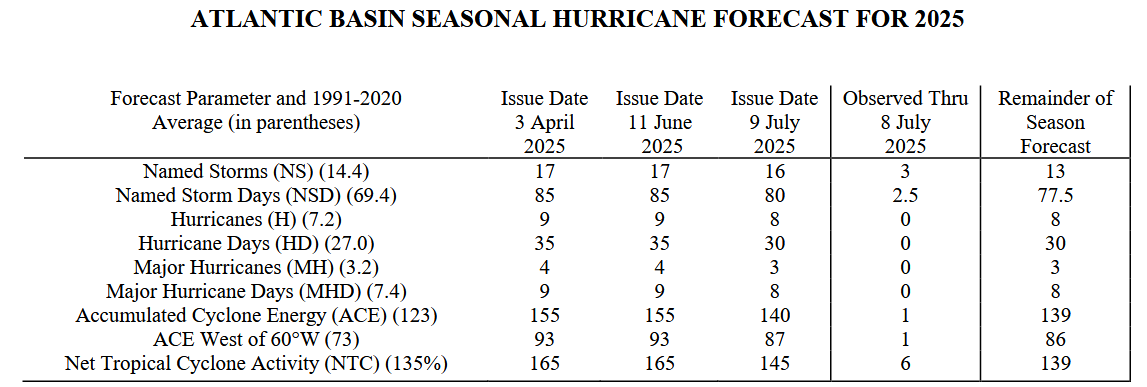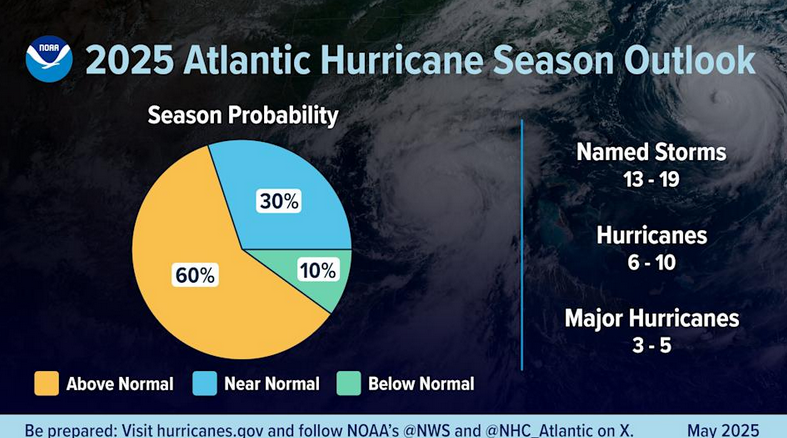2025 Hurricane Forecasts
Colorado State University Tropical Cyclones, Radar, Atmospheric Modeling, and Software Team - 9 July 2025

CSU anticipates that the 2025 Atlantic basin hurricane season will have above-normal activity. A warmer-than-normal tropical Atlantic combined with likely ENSO neutral (or potential La Nina) conditions typically provides a more conducive dynamic and thermodynamic environment for hurricane formation and intensification. CSU anticipates an above-average probability for major hurricanes making landfall along the continental United States coastline and in the Caribbean.
NOAA - 22 May 2025

The coming Atlantic hurricane season is expected to be busier than usual, US science agency NOAA has warned, just as cuts to American research are raising fears about the ability to track and prepare for these often deadly storms. NOAA's outlook for the 2025 Atlantic Hurricane Season indicates a 60% chance of an above-normal season. This year's above average forecast is expected for two main reasons. Firstly, sea surface temperatures are above average across most of the tropical Atlantic, although they are not as extreme as this time last year. Secondly, the natural weather pattern known as El Nino - which makes it harder for Atlantic hurricanes to develop - is not expected this year. ENSO-neutral conditions tend to favor Atlantic hurricanes due to lower wind shear. Since the current Atlantic high-activity era began in 1995, 21 of 30 (about 70%) seasons have had above-normal activity.
Atmospheric G2 and The Weather Company - 16 April 2025

We expect 19 storms to form in 2025, nine of which will become hurricanes and four of which will reach Category 3 status or stronger, according to the outlook. That's above the 30-year average tally for both hurricanes and storms. It's just a couple of hurricanes shy of 2024's total of 11 hurricanes. The AG2/TWC team is forecasting three hurricanes to make a U.S. landfall in 2025, two less than did so during the destructive 2024 hurricane season.
North Carolina State University - 15 April 2025
The 2025 Atlantic hurricane season will see 12 to 15 named storms forming in the Atlantic basin, according to researchers at North Carolina State University. The Atlantic basin includes the entire Atlantic Ocean, the Gulf of Mexico and the Caribbean Sea.
The number of named storms predicted is in line with recent averages, according to Lian Xie, professor of marine, earth and atmospheric sciences at NC State. The long-term (1951 to 2023) average of named storms is 11, and the more recent average (1994 to 2024) is 15 named storms. Of the predicted 12 to 15 named storms, six to eight may grow strong enough to become hurricanes (the historical average is six), with the possibility of two to three storms becoming major hurricanes.
Tropical Storm Risk (Euro Tempest) - 7 April 2025

The TSR (Tropical Storm Risk) April forecast update for North Atlantic hurricane activity in 2025 anticipates a season with activity close to the 1991-2020 climate norm. Although there is significant uncertainty at this lead time, we consider that the more likely scenario is for tropical North Atlantic and Caribbean Sea waters to be near or slightly above normal by August-September 2025, and for neutral ENSO conditions to be present through summer and autumn 2025. These two factors are both expected to have a neutral influence on the upcoming Atlantic hurricane season.
Weatherbell Analytics LLC - 7 April 2025

The 2025 Hurricane Season should have fewer impacts than 2024. Unlike last year, there are currently no clear landfall signals. An El Nino may develop, but likely won't be a huge factor if it does.
The Climate Adaption Center - 1 April 2025

The Climate Adaption Center is predicting another active year, with only a slight decrease in the number of Named Storms and Hurricanes compared to 2024 - and the same number of Major Hurricanes. Below-average wind shear is predicted for 2025, creating a favorable environment for storm development. Average mid-level moisture levels, combined with less Saharan dust than in 2024, will also contribute to increased storm formation. Rapid Intensification ("RI") is a major risk again this year. RI can, and often does, happen close to the coast, making the threat even more dangerous. With climate warming, the lead time for preventive action may be short.
And one more thing, the National Hurricane Center has updated its baseline for average Atlantic hurricane season activity from the 1981-2010 period to 1991-2020. This change reflects a rising trend, increasing the average number of named storms from 12 to 14.
AccuWeather - 26 March 2025

The Atlantic hurricane season is fast approaching, and early indications have forecasters worried that it will have similarities to the 2024 season, which was one of the most devastating and costliest on record. Water temperatures across the ocean, as well as in the Gulf and Caribbean, are already well above historical averages, and they will continue to run warm throughout most of the year. This will prime storms for explosive development.
Meteorologists gauge an entire season by analyzing accumulated cyclone energy (ACE). This measures the combined intensity of every tropical system throughout the season, with weak, short-lived storms producing little ACE while powerful, long-lived hurricanes generating a high amount. For the 2025 hurricane season, AccuWeather is predicting an ACE of 125 to 175, above the 30-year historical average of 123, and around the level measured during the 2024 season.




